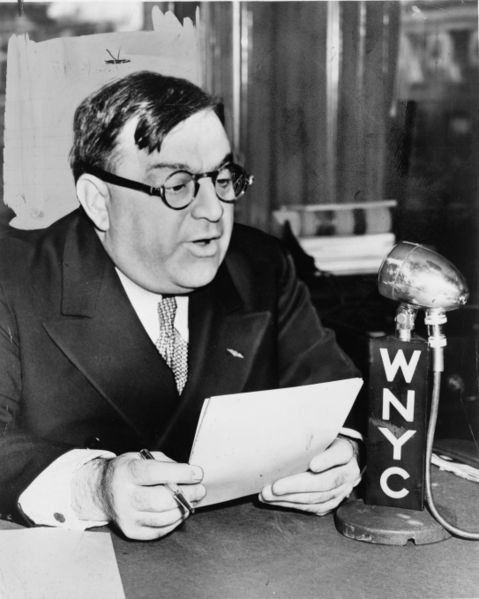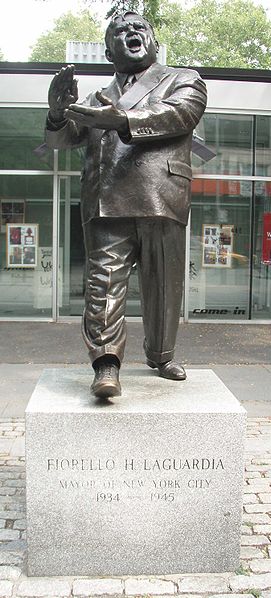<Back to Index>
- Physicist Max Born, 1882
- Composer Hector Berlioz, 1803
- Mayor of New York City Fiorello Enrico La Guardia, 1882
PAGE SPONSOR


Fiorello Henry La Guardia (born Fiorello Enrico La Guardia; December 11, 1882 – September 20, 1947) was Mayor of New York for three terms from 1934 to 1945. He was popularly known as "the Little Flower", the translation of his Italian first name, Fiorello, and, most likely, a reference to his short stature. A liberal Republican, he was a popular mayor and a strong supporter of the New Deal. La Guardia led New York's recovery during the Great Depression and became a national figure, serving as President Franklin D. Roosevelt's director of civilian defense during the run-up to the United States joining the Second World War.
La Guardia was born in Greenwich Village to an Italian lapsed-Catholic father, Achille La Guardia, from Cerignola, and a Triestine mother of Jewish Hungarian origin, Irene Coen Luzzato; he was raised an Episcopalian. His middle name "Enrico" was changed to "Henry" (the English form of Enrico) when he was a child. He lived in Prescott, Arizona, his mother's hometown, after his father was discharged from his bandmaster position in the U.S. Army in 1898. La Guardia served in U.S. consulates in Budapest, Trieste, and Rijeka (1901 – 1906). Fiorello returned to the U.S. to continue his education at New York University. During this time, he worked for New York Society for the Prevention of Cruelty to Children as an interpreter for the U.S. Bureau of Immigration at the Ellis Island immigrant station (1907 – 1910).
La Guardia married twice. His first wife was Thea Almerigotti, whom he married on March 8, 1919. She died of tuberculosis on November 29, 1921, at the age of 26. They had a daughter, Fioretta, born 1920, who died of spinal meningitis in 1921. La Guardia's second wife was Marie Fisher, whom he married in 1929. She had been his secretary while he was a member of the House of Representatives. They adopted two children, Jean Marie [daughter of first wife Thea's sister] and Eric.
La Guardia became Deputy Attorney General of New York in 1914. In 1916, he was elected to the U.S. House of Representatives, where he had a reputation as a fiery and devoted reformer. As a congressman, La Guardia represented an ethnically diverse slum district in East Harlem and, although barred from important committee posts because of his political independence, he was a tireless and vocal champion of Progressive causes. La Guardia continued to represent East Harlem almost continuously until 1933 with only two brief interruptions, first as a major in the United States Army Air Service in command of a unit of Ca.44 bombers on the Italian-Austrian front in World War I, and later to serve as President of the New York City Board of Aldermen from 1920 - 1922.
In 1919, La Guardia was chosen to run as the Republican candidate for the office of President of the New York City Board of Aldermen. His Democratic opponent was Robert L. Moran, an Alderman from the Bronx who had succeeded to that office in 1918 when Alfred E. Smith, who had been elected President in 1917, became Governor. Michael “Dynamite Mike” Kelly, commander of New York’s Third “Shamrock” Battalion, also joined the race on the ticket of the Liberty Party. Tammany Hall looked with alarm upon Kelly’s entrance into the campaign and tried to persuade him to withdraw his candidacy and throw his support behind Mr. Moran. When he refused, Tammany went to the New York Supreme Court and successfully sued to keep Kelly’s name off the ballot. When Election Day arrived, over 3,500 of Kelly’s supporters wrote his name on the ballot. This number was sufficient to defeat Moran, who lost to La Guardia by only 1,363 votes.
"Fio" La Guardia (as his close family and friends called him) won a seat in Congress again in 1922 and served in the House until March 3, 1933. Extending his record as a reformer, La Guardia sponsored labor legislation and railed against immigration quotas. In 1929, he ran for mayor of New York, but was overwhelmingly defeated by the incumbent Jimmy Walker. In 1932, along with Senator George Norris (R-NE), La Guardia sponsored the pro-union Norris-La Guardia Act. In 1932, he was defeated for re-election to the House by James J. Lanzetta, the Democratic candidate (1932 was not a good year for Republican candidates, and the 20th Congressional district was shifting from a Jewish and Italian-American population to a Puerto Rican population). As a congressman, LaGuardia was a tireless and vocal champion of progressive causes, from allowing more immigration and removing U.S. troops from Nicaragua to speaking up for the rights and livelihoods of striking miners, impoverished farmers, oppressed minorities, and struggling families. A goad to the era's plutocrats and their enablers in government, La Guardia fought for progressive income taxes, greater government oversight of Wall Street, and national employment insurance for workers idled by the Great Depression.
La Guardia was elected mayor of New York City on an anti-corruption Fusion ticket during the Great Depression, which united him in an uneasy alliance with New York's Jewish population and liberal bluebloods (WASPs). These included the architect and historian Isaac Newton Phelps-Stokes whose patrician manners La Guardia detested. Surprisingly, the two men became friends. Phelps-Stokes had nursed his wife during the last five years of her life, during which she was paralyzed and speechless due to a series of strokes. On learning of Phelps-Stokes's experience, so like his own, La Guardia ceased bickering and the two developed genuine affection.
Being of Italian descent and growing up in a time when crime and criminals were prevalent in New York, La Guardia loathed the gangsters who brought a negative stereotype and shame to the Italian community. When he was elected to his first term in 1933, the first thing he did after being sworn in was to pick up the phone and order the chief of police to arrest mob boss Lucky Luciano on whatever charges could be found. La Guardia then went after the gangsters with a vengeance, stating in a radio address to the people of New York in his high-pitched, squeaky voice, "Let's drive the bums out of town." In 1934, La Guardia went on a search-and-destroy mission looking for mob boss Frank Costello's slot machines, which La Guardia executed with gusto, rounding up thousands of the "one armed bandits", swinging a sledgehammer and dumping them off a barge into the water for the newspapers and media. In 1936, La Guardia had special prosecutor Thomas E. Dewey, a future Republican presidential candidate, single out Lucky Luciano for prosecution. Dewey led a successful investigation into Luciano's lucrative prostitution operation, eventually sending Luciano to jail with a 30-50 year sentence. The case was made into the 1937 movie 'Marked Woman', starring Bette Davis.
La Guardia was hardly an orthodox Republican. He also ran as the nominee of the American Labor Party, a union-dominated anti-Tammany grouping that supported Franklin D. Roosevelt for President beginning in 1936. La Guardia supported Roosevelt, chairing the Independent Committee for Roosevelt and Wallace with United States Senator George Norris during the 1940 presidential election. La Guardia was the city's first Italian-American mayor, but was not a typical Italian New Yorker. He was a Republican Episcopalian who had grown up in Arizona, and had a Triestine Jewish mother of Hungarian origin and a Roman Catholic turned atheist Italian father. He reportedly spoke seven languages, including Hebrew, Croatian, German, Hungarian, Italian, and Yiddish.
La Guardia's fans credit him for, among other things, restoring the economic lifeblood of New York City during and after the Great Depression. This was based on the theory that massive public works programs administered by his Parks Commissioner Robert Moses employed thousands of unemployed New Yorkers, and that his constant lobbying for federal government funds allowed New York to develop its economic infrastructure. Critics charged that the money was merely taken from others to spend on these projects, and that as the economy shrunk correspondingly in the sectors from which the money was taken, there was no net gain to the economy. He is remembered for reading the newspaper comics on WNYC radio during a 1945 newspaper strike, and pushing to have a commercial airport (Floyd Bennett Field, and later La Guardia Airport) within city limits. Responding to popular disdain for the sometimes corrupt City Council, La Guardia successfully proposed a reformed 1938 City Charter that created a powerful new New York City Board of Estimate, similar to a corporate board of directors.
He was an outspoken and early critic of Adolf Hitler and the Nazi regime. In a public address in 1934, La Guardia warned, "Part of Hitler's program is the complete annihilation of the Jews in Germany." In 1937, speaking before the Women's Division of the American Jewish Congress, La Guardia called for the creation of a special pavilion at the upcoming New York World's Fair "a chamber of horrors" for "that brown-shirted fanatic". La Guardia's sister, Gemma La Guardia Gluck, was arrested by the Germans in a roundup of Jews in Hungary in 1944. She was held under privileged conditions at Ravensbrück concentration camp and released after the war.
In 1940, one of the many interns serving in city government was David Rockefeller, who became his secretary for eighteen months in a "dollar a year" public service position. Although La Guardia took pains to point out that Rockefeller was only one of 60 interns, Rockefeller's working space was the vacant office of the deputy mayor.
In 1941, during the run-up to American involvement in World War II, President Roosevelt appointed La Guardia as the director of the new Office of Civilian Defense (OCD). The OCD was responsible for preparing for the protection of the civilian population in case America was attacked. It was also responsible for the maintenance of public morale, promoting volunteer service, and co-ordination with other federal departments to ensure they were serving the needs of a country in war. La Guardia remained Mayor of New York during this appointment, but after the attack on Pearl Harbor in 1941 he was succeeded at the OCD by a full-time director, James M. Landis.
According to Try and Stop Me by Bennett Cerf, La Guardia often officiated in municipal court.
He handled routine misdemeanor cases, including, as Cerf wrote, a man
who had stolen a loaf of bread for his starving family. La Guardia
insisted on levying the fine of ten dollars. Then he said "I'm fining
everyone in this courtroom fifty cents for living in a city where a man
has to steal bread in order to eat!" He passed a hat and gave the fines
to the defendant, who left the court with $47.50. La Guardia was the director general for the United Nations Relief and Rehabilitation Administration (UNRRA) in 1946. A
man of short stature, La Guardia's height is sometimes given as
5 feet 0 inches (1.52 m). According to an article in the New York Times, however, his actual height was 5 feet 2 inches (1.57 m). He became a member of Phi Mu Alpha Sinfonia music fraternity. He died of pancreatic cancer in his home at 5020 Goodridge Avenue, in the Riverdale section of the Bronx at the age of 64 and is interred at Woodlawn Cemetery in the Bronx.